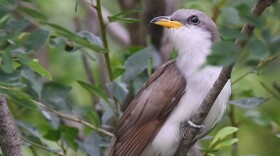
Diane Hope
Diane Hope, Ph.D., is a former ecologist and environmental scientist turned audio producer, sound recordist and writer. Originally from northern England, she has spent much of the last 25 years in Arizona and has been contributing scripts to Earth Notes for 15 years.
-
The ringtail can be tricky to see. They're the smaller cousins to raccoons and live in rocky habitats across the Southwest. With large rounded eyes and ears, they’re exceptionally well adapted for their elusive, nocturnal lifestyle.
-
The most productive aquifer in northern Arizona is named after its main water-bearing rock unit — the Coconino Sandstone. The Coconino Aquifer underlies 27,000 square miles west of Flagstaff and into New Mexico and southern Utah.
-
Not only can smoke cause health risks for residents... it’s a cause of concern for astronomers, too.
-
You’ve likely seen pictures of the Very Large Array Radio Telescope near Socorro in New Mexico, which has been featured in movies like Contact and Independence Day. But you may not know northern Arizona has its own Very Large Array on Anderson Mesa.
-
Like humans on a long road trip, migrating birds need spots to rest and refuel on their extraordinary journeys.
-
Pictorial weaving is an innovation born out of traditional Navajo geometric designs. Since the 1970s, the style has become increasingly popular among…
-
Wild donkeys, also known as burros, first arrived in Arizona with early Spanish colonists, with many more imported by miners in the 1800s. They evolved…
-
Edward P. Dozier was a pioneering anthropologist and linguist in the 1950’s and 60’s, one of very few Native Americans at that time who were professional,…
-
Showering is a significant use of water in American homes. On average, individuals typically take 8-10 minute showers every day, using about 17 gallons of…
-
Elevated E. coli levels are, unfortunately, not unheard of in Oak Creek – whether it be from a sewage spill like the one earlier this summer, or because…












